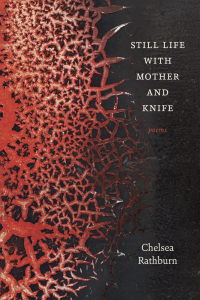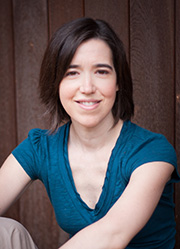by JESSICA Q. STARK

Chelsea Rathburn, Still Life with Mother and Knife (LSU Press, 2019), pp. 80
I read Chelsea Rathburn’s Still Life with Mother and Knife in the wake of my own new motherhood. My son, an 18-month-old bundle of impulses, wakes me up every dawn with a simple refrain: “MAMADADA.” Looking back, it was so difficult to predict in those eternal nine months what motherhood would entail. I received my share of advice, but I never really believed it would apply to my life, my child, or my body. And for the most part, it didn’t. It couldn’t. I bought the recommended books and checked out more from the library. The process of research, my outlet for almost all of life’s mysteries, provided a sense of refuge in attempting to attain some impossible knowledge. I admit the months of research did little in the end to help me prepare for the shifts that motherhood demands. Yet the process of searching, however useless the advice I collected, helped to stave off embracing the obvious: maternity as a dark space of unknowing.
Rathburn’s third poetry collection, Still Life with Mother and Knife, examines the contours of maternity with a keen sense of its essential unknowability. Her poems cast intimate shadows on the image of motherhood that is mischaracterized by so many sanitized, Hallmark versions of maternal experience. Unexpectedly dark thoughts leak into Rathburn’s incisive depiction of new motherhood, sustained by a unique combination of fairy tale folklore, self-mythology, and lyrical confessionalism. In so doing, Rathburn’s dangerous terrain invites a reexamination of maternal experience as inextricably linked (albeit counterintuitively) with destructive impulses, violence, and death. Claudia Dey’s recent article, “Mothers as the Makers of Death” in The Paris Review thoughtfully links maternity not just to the birth of a new life, but also to the birth of a new sense of mortality. She writes,
“No one had warned me that with a child comes death. Death slinks into your mind. It circles your growing body, and once your child has left it, death circles him too. It would be dangerous to turn your attentions away from your child—this is how the death presence makes you feel.”
Rathburn weaves mortality, artistic production, and femininity together in critical reflection of how the female body is often depicted throughout art history. Relatedly, she reveals women’s lived experiences, including motherhood, as superseding its conventional casts. Still Life with Mother and Knife navigates the viciousness of womanhood, in its many stages and depictions, in the wake of patriarchy, postpartum depression, aging, and medical trauma. The result is a haunting portrayal of femininity as a dark fairy tale, all shadows and unseen predators, without heroes or happy endings.
The first section of Still Life with Mother and Knife includes nearly a dozen poems that include “Introduction to” in their titles. In “Introduction to Home Economics,” Rathburn details a moment when her speaker accidentally cuts her mother’s hand with a carving knife on Halloween. The poem concludes:
“Each Halloween, she brought it up again
reminding me what I had done, how I had hurt her,Never imagined the frail, sheer speed
though she was the one who handed me the knife.”
Like many of the poems in this collection, both mothers and children are potentially dangerous to each other; an unexpected seed at the base of familial love is an unsettling impulse towards destruction, darkness, and disrepair. After all, the beginning of maternal life starts with the emblematic severance between mother and child—the umbilical cut. In some respects, Rathburn highlights the under-acknowledged morbidities of child rearing. As a parent, you foster a life that will hopefully outlive your own; maternity ushers in a form of self-erasure, a death of sorts. Rathburn sustains this tension between intimacy and self-preservation, between the psychological holding and loosening necessary for simultaneously nurturing a child and oneself. Still Life with Mother and Knife lead us down the obscured path, with a much more truthful gaze, into the unknowability and danger of claiming space as both a mother and a woman in the contemporary moment.
In “Introduction to Thanatology,” Rathburn links death with the unexpected territory of young girlhood, writing:
“sometimes how easy it was to slip
free from the body, like stepping from a robe,
and how certain I felt in that black space.
my friends and the darkness calling me.”
Here, Rathburn connects thanatology, the scientific study of death, to the scene of a lighthearted slumber party among girls. Her attention to girlhood challenges its frequent misapprehension, like new motherhood, as uncomplicated and sweet. Death and danger line the trail, even though “[i]t’s hours before dark.” These accumulative introductions operate as false starts in a story with no end, in which the reader arrives repeatedly to a multitude of varying projections that are unfairly placed on girls, women, and femininity.
The collection unfolds into poems more directly on the speaker’s own motherhood, which highlight the monotonous trauma of adapting to the demands of caretaking for a newborn. In “Postpartum: Lullaby,” Rathburn mimes the rhyming couplet structure typical to babies’ lullabies to describe the disorientation of new motherhood as “they rock and rock and rock / beside a cold and indifferent clock.” In addition to invoking the lurch of postpartum depression, Rathburn’s poems bring attention to the specific, mania-inducing admixture of sleep deprivation, repetitive action, and the sheer loneliness in the calculation of nursing hours for women. The fractions of moments and glimpses of images in these poems never fully add up to a holistic “whole” of what it means to be a mother, a girl, or a woman at any single moment. Rathburn’s poems relay “the truth is there is no single truth” on maternal experience, allowing for a kind of darkness to register as significant in a more complete version of women’s lived experiences. In this way, Rathburn’s poems dismantle a long history of erasure and the suppression of pain and rage in conventional, artistic representations of women and girls.
The title of Still Life with Mother and Knife nods to Rathburn’s implication of a number of conventional images of women in art history and their provocative failures. In “Variations on a theme: Delacroix’s Medea, 1920-1862,” she writes:
His Furious Medea begin to hunt words.
Is composed, a study in stillness more horrifying
for its restraint: the tall isoceles
their bodies make”
Médée Furieuse by Eugène Delacroix, painted in 1838, depicts Medea from Greek mythology, brandishing the knife with which she will kill her own children in revenge of her ex-lover. In Rathburn’s poem, however, she acknowledges the still serenity of the scene, the beautiful triangle of their forms—that even in this depiction of a most wild, “barbarous” woman, Delacroix cannot allow Medea her own aesthetically unharmonious rage on the canvas. At the conclusion of this poem, she describes Medea as a threat to the painter who returns frustrated again and again to redraw her: “she clutches the dagger still, ever lovely, / ever ready to embrace or slit his throat.” Rathburn inverts the power structure of male creator and feminized artistic creation, allowing Medea—unrealized and vengeful—to respond to and reject the painter’s hand.

The concept of restraint in this poem interestingly reflects an undercurrent of consistency within Rathburn’s collection writ large. Her poems lyrically wind around easily discernible, feminist topics: “Introduction to Patriarchy” prompts and delivers on its title. I found myself, at times, wishing Rathburn, like Medea, to slice into a wilder script—to untidy her own narratives. I desired for a break from the established chronology of poems that, without exception, have clean, mellifluous endings. In other words, antithesis frames the content of convention as well; I longed for an undoing of their forms. Or as Rathburn herself writes herself in “Story Time,” “this is no picture book, there’s no joyous reunion, / no tears and repentance, no moralizing lesson.” Yet I understand that this lyrical orderliness also presents, as she writes, “a study in stillness more horrifying / for its restraint.” They are beautiful and beautiful-sounding poems that tell the terrible story of a tender kind of holding of self, image, and child on a rocky path. That paradox, of beauty holding terror, evocatively relays the push and pull of violence and creation, of birth and imminent mortality, of the wild feminine contained within its tamed images.
My baby, now a toddler, has been learning new words and phrases every day. The latest phrase, becoming increasingly useful in his limited communication with me, is “too scary.” These days, a large dog on our walk or the high setting of the blender typically evokes this phrase. Reading Rathburn’s book alongside raising my son—a son who recently understands that some things are “too scary”—brings me to an uncomfortable edge in my own motherhood: the darkness in the path, the inevitable moments in my life, in my son’s life, that will come when I won’t be there to protect him. Because there is so much that is, in fact, “too scary” for a child, a girl, a woman, a vulnerable human in this world. As a mother, I understand with heartbreak that I am the bearer of his mortality and a protector with limited means. Or as Rathburn’s book teaches: that we all have “to learn to walk the woods alone.”

